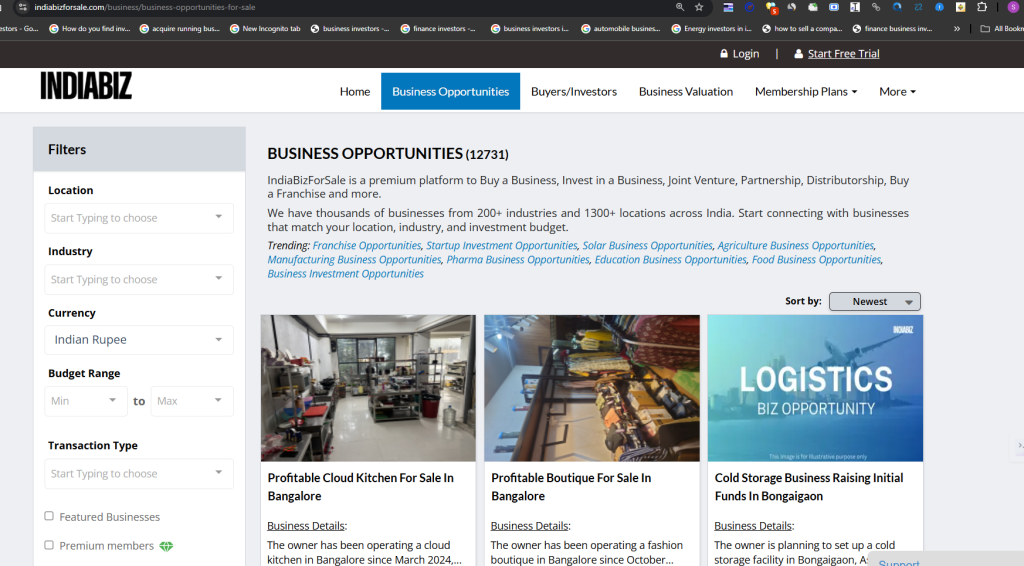Dreaming of becoming an entrepreneur in India? Or Curious to know how you can start your journey as a businessman? You’re not alone. Everyday, thousands of Indians search for “how do I become an entrepreneur” or “how can I be a successful businessman” — and 2025 is the perfect time to begin.
In India, entrepreneurship spirit is more vibrant than ever before. From thriving street shops to country-shaping tech companies, entrepreneurs are shaping the way for the future of the country.

Becoming an entrepreneur in 2025 isn’t limited to just one traditional path.
Today, there are two intelligent ways to start your entrepreneurial journey:
- The Traditional Way: Starting your business from the beginning.
- The Modern Way: Buying a running business or partnering a growing startup.
In this guide, both paths offer opportunities, but they come with different risks, rewards, and timelines.
In this guide, you’ll learn both approaches in detail with real examples, real stats, and step-by-step action plans — so you can confidently choose your own entrepreneurial path.
Traditional Method – Start Your Own Business (10 Detailed Steps)
Traditional method is most entrepreneurs follows- doing everything from the beginning.
Starting from scratch means creating something entirely new — finding a problem, building a solution, getting customers, and scaling your business step by step.

As of January 15, 2025, the Department for Promotion of Industry and Internal Trade (DPIIT) has officially recognized 1,59,157 startups in India. This marks a significant increase from approximately 500 startups in 2016, underscoring the rapid growth of India’s startup ecosystem.
This is the classic image of entrepreneurship: you think of an idea, put in your time, money, and energy, and build your dream over time.
Many well-known entrepreneurs in India did this:
- Kunal Shah started Freecharge and later CRED from scratch.
- Falguni Nayar, after quitting her job at Kotak Mahindra Bank, built Nykaa into a billion-dollar company.
It’s hard work, but building from ground zero gives you absolute freedom to create exactly what you dream.
Below, we have crafted 10 steps based on two decade of experienced that will help you to start your entrepreneurial journey.
Step 1: Find a Real Problem
Every successful business begins with solving a real-world problem. It’s crucial to not just run after ideas that “sound cool” but find something people actually struggle with.
Daily life is full of challenges In India. From poor transportation to complex banking systems, from lack of quality education in small towns to unreliable health services.
You need to spend time observing people around you. Talk to your friends, family members, neighbors, local store owners. Ask them questions such as — “What is the biggest headache you face daily?” or “What service do you wish someone would offer?”
Example:

Delhivery founders noticed a huge gap in delivery services for e-commerce companies and built one of India’s largest logistics startups.
Tip:
Keep a notebook where you write down every small or big problem you notice. Don’t judge whether it’s a “big enough idea” yet — just collect observations.
Step 2: Define Your Unique Solution
After you have identified a problem, think thoroughly about what could be the best solution. The goal is to come up with something that either saves time, saves money, or gives better results.
For example, if public transport is unreliable in your city, could a fleet of affordable electric rickshaws solve the problem? Think differently. It’s not about inventing something new; it’s about serving better.
Example:

Rapido made it easy for people to book bike rides — which are cheaper and faster than taxis in crowded Indian cities.
Spend time writing a clear “Problem-Solution Statement”:
- Problem: People waste 2 hours daily stuck in traffic.
- Solution: On-demand bike taxis that cut travel time by 50%.
Tip:
Use brainstorming techniques like “Mind Mapping” to think of multiple solutions and choose the best one.
Step 3: Validate That People Will Pay
Many businesses fail because nobody really wants to pay for their “great idea.” You must verify genuine demand before heavily investing.
Easy ways to validate:
- Share your idea with at least 50 people (friends, strangers, local businesses) and collect honest feedback.
- Run an online survey using Google Forms.
- Create a small Facebook or Instagram ad campaign targeting your city and see how many people click.
Example:

Zomato founders first started by listing menus of restaurants around Delhi. Only after good response they expanded further.
Important:
People saying “Good idea!” is not validation. People pre-paying or signing up is validation.
Step 4: Study Competitors Closely
Before starting your business, check who else is solving this problem. Google “Top companies in [your idea]” or look on platforms like IndiaMart, Justdial, and App stores.
Competition is not a bad thing.
If there are competitors, it indicates there is demand. But you need to figure out how you’ll be better, cheaper, or quicker.
Example:

Acko Insurance entered a saturated market but offered digital-only, superfast insurance policies — no paperwork, no agents.
How to study competitors:
- Check their websites and products.
- Read Google reviews.
- Understand what customers complain about.
Turn competitor weaknesses into your strengths.
Step 5: Create a Strong Business Model
A business model means having an understanding of:
- Who is going to pay you?
- How will you make money?
- How much will it cost you to provide the service?
There are many types of business models — subscription, commission, direct sales, freemium, etc
Example:

Dunzo makes money by charging customers a delivery fee and taking commissions from shops.
Create a simple Business Model Canvas:
- Customer Segments
- Value Proposition
- Channels
- Revenue Streams
- Cost Structure
Tip:
Use free tools like “Canvanizer” or Startup India portal templates.
Step 6: Plan Initial Funding
You don’t need crores to start a business. Many great companies started with small capital. As per economics times 2024, 88% of Indian startups are bootstrapped in their early stages
Sources of initial funding:
- Your own savings
- Borrowing small amounts from family or friends
- Government schemes like Mudra Loan (up to ₹10 lakh without collateral)
- Small angel investors
Important:
Start lean. Avoid renting big offices, hiring big teams, or buying fancy stuff early.
Step 7: Legally Register Your Business
You have to legally secure your brand. Registering your business is easy in India nowadays, with the help of online portals.
Options:
- Private Limited Company — good for startups planning to raise funds.
- LLP (Limited Liability Partnership) — ideal for service businesses.
- Sole Proprietorship — ideal for single-person businesses.
Steps:
- Apply online on MCA website.
- Get a PAN, GST registration if needed.
- Open a business bank account.
Bonus Tip:
Register as MSME (Micro, Small and Medium Enterprises) to avail government advantages such as reduced loan interest rates and grants.
Step 8: Release Your MVP (Minimum Viable Product)
Rather than building a perfect product, develop a minimal version with just the essential features — something that addresses the primary issue.
Example:

Ola started with just a simple booking website before launching a mobile app.
How to launch MVP:
- Sell first products manually.
- Offer basic services personally.
- Use WhatsApp, Google Forms, Instagram.
Remember: Done > Perfect
You can keep improving later based on real feedback.
Step 9: Win Your First 100 Customers
Don’t focus on mass advertising yet. Your focus is on reaching your first 100 paying clients.
Why first 100 matter:
- They give real feedback.
- They confirm that people want your product.
- They help in word-of-mouth marketing.
How to get first 100:
- Personal network (friends and family, LinkedIn)
- Local ads (posters, pamphlets, WhatsApp groups)
- Targeted Facebook and Instagram ads.
Example:

Mamaearth reached early customers through influencer shoutouts.
Step 10: Scale Your Business Smartly
Once you have customers, a working model, and some revenue, it’s time to grow — but smartly.
Scaling smartly means:
- Investing profits into marketing.
- Hiring slowly and wisely.
- Keeping a close eye on costs.
You can also raise external funding through Angel or private Investors, Seed Funds, or Venture Capital if needed.
Example:

Zerodha scaled without external funding and became India’s No.1 brokerage by focusing on customer satisfaction.
2. Why People Choose This Path
Freedom. Passion. Legacy.
Many individuals choose to start their own business because they want total creative control, flexibility in decision-making, and the satisfaction of building something meaningful.
According to a report by Edelman, More than 70% of Indian youth opt for entrepreneurship rather than conventional jobs as they desire independence, according to a report by Edelman.
In India especially, family business traditions are strong. Many new entrepreneurs want to create a legacy, just like the Tatas, Birlas, and Ambanis did decades ago.
Yes, the risks are high:
- 90% of startups fail within the first 5 years (as per NASSCOM report 2022).
- Competition is tough.
- Funding is challenging, especially in early stages.
But for those who survive, the rewards — financial, emotional, and social — are massive.
Option 2: Modern Approach – Acquire or Join a Growing Business (Full Journey)
This is the new modern and nowadays most prefered and secure way to not just start your entrepreneurial journey but take it to the next level with quickly with smooth manner.
Below are the 6 steps (shared by business leaders) to help your become an entrepreneurs following modern approach:
Stage 1: Decide Your Path (Buy or Join)
The new way of entrepreneurship doesn’t necessarily involve starting from scratch. Most entrepreneurs and big giant choose to acquire or invest in what is already built and scale.
So, you can buy an ongoing profitable business or join an early-stage venture as a founding team member.
Both are smart strategies with faster growth and lower risk.

> If you want to become a single person owner with 100% stake in a company, you can acquire an existing company which can give you instant revenue, customers, and brand value along with removing the risk of starting from scratch struggle.
> If you want to gain experience, networking and want to become a part of something that is already making a huge impact, you can invest in and take a stake to start your growth entrepreneurial journey.
Example:
Early employees at CRED, Freshworks, Ola made crores when the companies grew or went public.
The IT professionals from Kerala acquired a local SAAL based company from IndiaBizForSale and started his business journey.
Choose based on:
- Goal
- Your budget
- Your age
- Your appetite for risk and hard work
Remember, both paths lead to entrepreneurship — just different styles!
Stage 2: Search for the Right Opportunity
Once you’ve made up your mind, the next is to look for the right business or startup to partner with.
For acquiring a business:
- Sites like Indiabizforsale.com, businessforsale.com, feature thousands of running businesses for sale.

- Look for businesses with 2–5 years of steady revenue and good customer feedback.
Example:
Buying a running café, a logistics business, or a D2C brand (based on your preferences).
For joining startups:
- Platforms like AngelList India, LinkedIn Startups Jobs, and Foundit.in are perfect.
- Search for startups in hot sectors: Fintech, Healthtech, Agritech, D2C brands that align your interest.
Look for startups that:
- Recently raised funding (Seed, Series A).
- Have strong leadership teams (Google them!).
- Are growing 20%–50% monthly.
Tip:
Explore IndiaBizForSale for multiple options with direct access, Network with founders directly on LinkedIn and startup events such as TechSparks (YourStory), TIE Delhi NCR, Headstart India.
Finding the right opportunity is 50% of your success!
Stage 3: Evaluate Carefully Before You Commit
Don’t rush into buying a business or joining a startup just because it sounds exciting.
Due diligence is the key.
If buying a business:
- Check last 3 years of financial statements: revenue, profits, expenses, debt.
- Analyze customer base: Is there repeat business? Are customers loyal?
- Understand why the owner is selling: Retirement? Losses? Market shift?
- Inspect legal documents: GST returns, income tax filings, property leases.
If joining a startup:
- Research funding status (Crunchbase, Tracxn India).
- Study growth charts: Active users, revenue growth.
- Evaluate the team: Strong leaders attract strong teams.
Example:

GlobalBees became a unicorn by acquiring small profitable brands after detailed due diligence.
Tip:
Invest at least 30–45 days evaluating before finalizing. Get a CA and a legal advisor — they cost ₹15k–₹30k but can save you lakhs in the future!
Smart evaluation = Safe and profitable entrepreneurship.
Stage 4: Close the Deal or Accept the Offer
Now comes the action part — signing the deal or accepting the offer!
If buying a business:
- Negotiate price smartly — based on revenue, profit, brand value.
- Always use a Business Sale Agreement.
- Opt for staggered payments (some upfront, some based on future performance).
- Transfer all primary assets: trademarks, website, social media handles, customer databases.
If joining a startup:
If you plan to invest money in a startup, either in exchange for equity (ownership) or debt (loan with interest), you must understand the key terms very carefully.
- Valuation: How much is the startup worth today? A wrong valuation can harm your returns later.
- Equity Share: What percentage of ownership will you get for your investment?
- Dilution Risk: In future funding rounds, will your ownership get reduced?
- Exit Rights: How and when can you sell your shares or recover your money?
- Debt Terms (if applicable): What is the repayment schedule? What interest rate will you get?
Example:

Early investors in startups like OYO, Paytm, and Zerodha multiplied their money by 100x–500x over a few years by investing at the right stage.
Tip:
Before investing, always consult a startup lawyer or an investment advisor.
Understand the risks — early-stage startups are high-reward but high-risk too.
Smart investments help you kick-start your entrepreneurial journey with strong financial growth!
Stage 5: Operate and Modernize the Business
Congratulations! Now you are officially a business owner or a core team entrepreneur.
Your next step is operating smartly and growing rapidly.
If you bought a business:
- Understand every key operation, customer, supplier, and process before making changes.
- Build strong relationships with existing employees to retain critical talent and knowledge.
- Analyze cash flow, profit margins, liabilities, and outstanding dues thoroughly.
- Identify top customers and protect important client relationships immediately.
- Verify all licenses, tax filings, contracts, and legal compliances are updated.
- Evaluate current systems and processes to find inefficiencies and quick improvement areas.
- Identify any hidden risks like legal issues, supplier dependencies, or customer concentration.
- Personally connect with major clients to build trust and reassure them about continuity.
- Implement small visible improvements to boost internal morale and external reputation.
- Create a 90-day action plan focused on stabilizing operations and preparing for smart growth.
If you joined a startup:
- Understand the startup’s vision deeply to guide your involvement smartly.
- Build a personal bond with the founders based on trust and transparency.
- Analyze current burn rate and runway to predict funding needs early.
- Clarify your exact role — whether advisor, mentor, or strategic investor.
- Support recruitment of strong leadership talent where the startup lacks.
- Advise on critical decisions like pivoting, fundraising, and market expansion.
- Help validate product-market fit by gathering honest customer feedback.
- Track vital metrics like MRR, CAC, and churn without micromanaging.
- Open fundraising doors by introducing the startup to your investor network.
- Mentor patiently, understanding that real startup success often takes 5–7 years.
Example:
Small hotels acquired in March 2024 were turned into profitable boutique hotels by digitizing marketing and improving customer service.
Tip:
Use India’s government digital support schemes — Digital MSME scheme, Skill India training programs.
Operating smartly is where real money and real respect is made!
Stage 6: Plan for a Big Exit or Build a Long-Term Brand
In the modern approach, you should already think about exit planning or brand building from day one.
If you own a business:
- Grow revenues and profits for 3–5 years.
- Sell it to bigger players (exit) OR
- Start franchising your business (expand faster).
If you’re in a startup:
- Stay involved until major liquidity events like an acquisition (startup gets bought) or IPO (company lists on the stock market).
- Sell your stake smartly when the startup succeeds.
- Some startups allow early investors to partially sell their equity during secondary sales rounds.
Example:

Freshworks’ IPO made many early investors and seed funders earn massive multi-crore returns.
Tip:
Think big but act step by step.
Build a strong team, strong customer loyalty, and strong financial discipline.
Your exit (or your legacy) will depend on how well you scale and brand your venture.
Your Entrepreneurial Journey Awaits
Today, in India, entrepreneurship is not just an option, it’s an opportunity of a lifetime.
You can either:
- Follow the traditional way and build your dream business from scratch.
- Or take the smart modern route by acquiring an existing business or joining a booming startup journey.
Whatever path you choose, the keys are:
- Solve real problems
- Validate before scaling
- Build strong foundations
- Stay consistent and smart
Remember, it’s never about ideas alone, it’s about execution.
The best time to start is now.
Thank you for coming so far. Now you know everything to become an successful entrepreneur.
If you have concern or need further guidance, our experienced industry leaders are more than happy to assist you, you can write us at [email protected].
